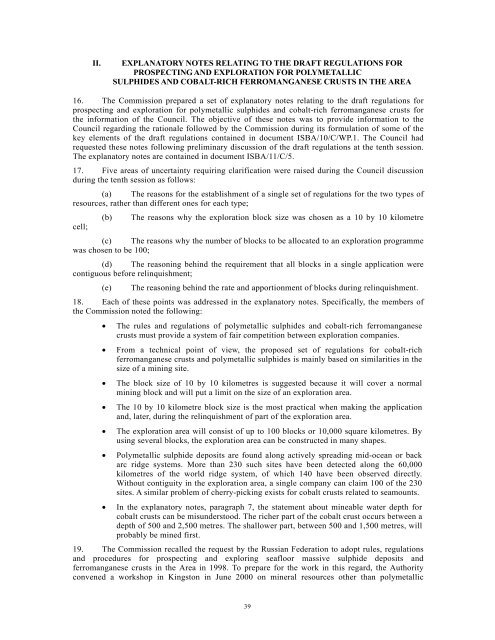Selected Decisions and Documents of the Eleventh Session
Selected Decisions and Documents of the Eleventh Session
Selected Decisions and Documents of the Eleventh Session
Create successful ePaper yourself
Turn your PDF publications into a flip-book with our unique Google optimized e-Paper software.
II.<br />
EXPLANATORY NOTES RELATING TO THE DRAFT REGULATIONS FOR<br />
PROSPECTING AND EXPLORATION FOR POLYMETALLIC<br />
SULPHIDES AND COBALT-RICH FERROMANGANESE CRUSTS IN THE AREA<br />
16. The Commission prepared a set <strong>of</strong> explanatory notes relating to <strong>the</strong> draft regulations for<br />
prospecting <strong>and</strong> exploration for polymetallic sulphides <strong>and</strong> cobalt-rich ferromanganese crusts for<br />
<strong>the</strong> information <strong>of</strong> <strong>the</strong> Council. The objective <strong>of</strong> <strong>the</strong>se notes was to provide information to <strong>the</strong><br />
Council regarding <strong>the</strong> rationale followed by <strong>the</strong> Commission during its formulation <strong>of</strong> some <strong>of</strong> <strong>the</strong><br />
key elements <strong>of</strong> <strong>the</strong> draft regulations contained in document ISBA/10/C/WP.1. The Council had<br />
requested <strong>the</strong>se notes following preliminary discussion <strong>of</strong> <strong>the</strong> draft regulations at <strong>the</strong> tenth session.<br />
The explanatory notes are contained in document ISBA/11/C/5.<br />
17. Five areas <strong>of</strong> uncertainty requiring clarification were raised during <strong>the</strong> Council discussion<br />
during <strong>the</strong> tenth session as follows:<br />
(a) The reasons for <strong>the</strong> establishment <strong>of</strong> a single set <strong>of</strong> regulations for <strong>the</strong> two types <strong>of</strong><br />
resources, ra<strong>the</strong>r than different ones for each type;<br />
(b) The reasons why <strong>the</strong> exploration block size was chosen as a 10 by 10 kilometre<br />
cell;<br />
(c) The reasons why <strong>the</strong> number <strong>of</strong> blocks to be allocated to an exploration programme<br />
was chosen to be 100;<br />
(d) The reasoning behind <strong>the</strong> requirement that all blocks in a single application were<br />
contiguous before relinquishment;<br />
(e) The reasoning behind <strong>the</strong> rate <strong>and</strong> apportionment <strong>of</strong> blocks during relinquishment.<br />
18. Each <strong>of</strong> <strong>the</strong>se points was addressed in <strong>the</strong> explanatory notes. Specifically, <strong>the</strong> members <strong>of</strong><br />
<strong>the</strong> Commission noted <strong>the</strong> following:<br />
• The rules <strong>and</strong> regulations <strong>of</strong> polymetallic sulphides <strong>and</strong> cobalt-rich ferromanganese<br />
crusts must provide a system <strong>of</strong> fair competition between exploration companies.<br />
• From a technical point <strong>of</strong> view, <strong>the</strong> proposed set <strong>of</strong> regulations for cobalt-rich<br />
ferromanganese crusts <strong>and</strong> polymetallic sulphides is mainly based on similarities in <strong>the</strong><br />
size <strong>of</strong> a mining site.<br />
• The block size <strong>of</strong> 10 by 10 kilometres is suggested because it will cover a normal<br />
mining block <strong>and</strong> will put a limit on <strong>the</strong> size <strong>of</strong> an exploration area.<br />
• The 10 by 10 kilometre block size is <strong>the</strong> most practical when making <strong>the</strong> application<br />
<strong>and</strong>, later, during <strong>the</strong> relinquishment <strong>of</strong> part <strong>of</strong> <strong>the</strong> exploration area.<br />
• The exploration area will consist <strong>of</strong> up to 100 blocks or 10,000 square kilometres. By<br />
using several blocks, <strong>the</strong> exploration area can be constructed in many shapes.<br />
• Polymetallic sulphide deposits are found along actively spreading mid-ocean or back<br />
arc ridge systems. More than 230 such sites have been detected along <strong>the</strong> 60,000<br />
kilometres <strong>of</strong> <strong>the</strong> world ridge system, <strong>of</strong> which 140 have been observed directly.<br />
Without contiguity in <strong>the</strong> exploration area, a single company can claim 100 <strong>of</strong> <strong>the</strong> 230<br />
sites. A similar problem <strong>of</strong> cherry-picking exists for cobalt crusts related to seamounts.<br />
• In <strong>the</strong> explanatory notes, paragraph 7, <strong>the</strong> statement about mineable water depth for<br />
cobalt crusts can be misunderstood. The richer part <strong>of</strong> <strong>the</strong> cobalt crust occurs between a<br />
depth <strong>of</strong> 500 <strong>and</strong> 2,500 metres. The shallower part, between 500 <strong>and</strong> 1,500 metres, will<br />
probably be mined first.<br />
19. The Commission recalled <strong>the</strong> request by <strong>the</strong> Russian Federation to adopt rules, regulations<br />
<strong>and</strong> procedures for prospecting <strong>and</strong> exploring seafloor massive sulphide deposits <strong>and</strong><br />
ferromanganese crusts in <strong>the</strong> Area in 1998. To prepare for <strong>the</strong> work in this regard, <strong>the</strong> Authority<br />
convened a workshop in Kingston in June 2000 on mineral resources o<strong>the</strong>r than polymetallic<br />
39
















